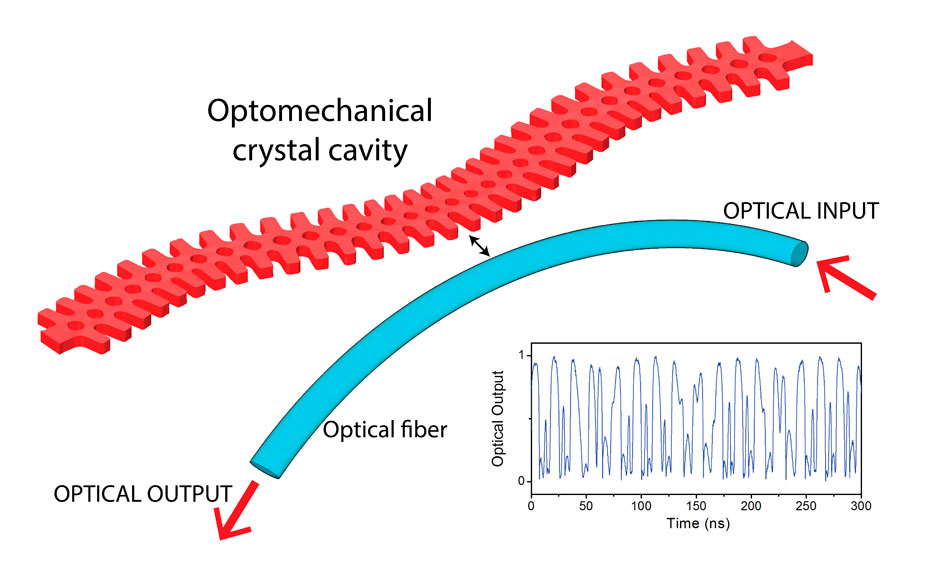Tuesday, 18 April 2017
Optomechanical crystals to enable chaos-based secure data communications
Researchers from ICN2's Phononic and Photonic Nanostructures (P2N) Group published a study showing how the complex dynamics, including chaos, of optical nonlinearities can be controlled using optomechanical crystals and changing the parameters of the excitation laser. This discovery could allow information to be coded by introducing chaos into the light that carries it.

Light is essential for modern optical fiber-based communications. Optomechanical crystals are designed at the nanoscale to allow the confinement of photons and mechanical motion in a common physical volume. Such structures are being studied in complex experimental setups and could have an impact on the future of telecommunications. The interaction of the photons and the mechanical motion is mediated by optical forces leading to a strongly modulated beam of continuous-wave light after interacting with an optomechanical crystal. In optomechanics, optical nonlinearities are usually regarded as detrimental and efforts are made to minimise their effects. What ICN2 researchers propose is to harness them to transport coded information. Initiatives such as PHENOMEN, a European project led by ICN2, aim to lay the foundations of a new information technology by combining photonics, radio-frequency signal processing and phononics.
Researchers in the Phononic and Photonic Nanostructures (P2N) Group, led by the ICREA Research Prof. Dr Clivia Sotomayor-Torres at ICN2, published an article in Nature Communications presenting the complex non-linear dynamics observed in silicon optomechanical crystal. Dr Daniel Navarro-Urrios is the first author of this article describing how a continuous-wave, low-power laser source is altered after traveling through one of these structures that combine the optical and mechanical properties of light and matter. The article includes authors from the Department of Physics at the Universidad de La Laguna (Spain) and the Nanophotonics Technology Center at the Universitat Politècnica de Valencia (Spain).
The paper reports the nonlinear dynamics of an optomechanical cavity system. The stable intensity of a laser beam was affected by factors such as thermo-optic effects, free-carrier dispersion and optomechanical coupling. The number of photons stored in the cavity affects and is affected by these factors, creating a chaotic effect that researchers were able to modulate by smoothly changing the parameters of the excitation laser. The authors demonstrate accurate control when activating a heterogenous variety of stable dynamical solutions.
The results of this work lay the foundations for a low-cost technology that can achieve high security in optical communications using chaos-based optomechanical cryptographic systems. It is possible to introduce dynamical changes in the light beam traveling along an optical fiber by using an optomechanical crystal. The original light conditions could be reestablished given the parameters of the excitation laser and the optomechanical crystal that introduced those dynamical changes are known. Thus, by linking with optical fibers two integrated chips containing equivalent optomechanical cavities it would be possible to secure information introducing chaos in the light beam at the emitting point and suppressing it at the reception point.
Article reference:
Daniel Navarro-Urrios, Néstor E. Capuj, Martín F. Colombano, P. David García, Marianna Sledzinska, Francesc Alzina, Amadeu Griol, Alejandro Martínez & Clivia M. Sotomayor-Torres. Nonlinear dynamics and chaos in an optomechanical beam. Nature Communications 8, 14965 (2017); doi:10.1038/ncomms14965
https://www.nature.com/articles/ncomms14965

